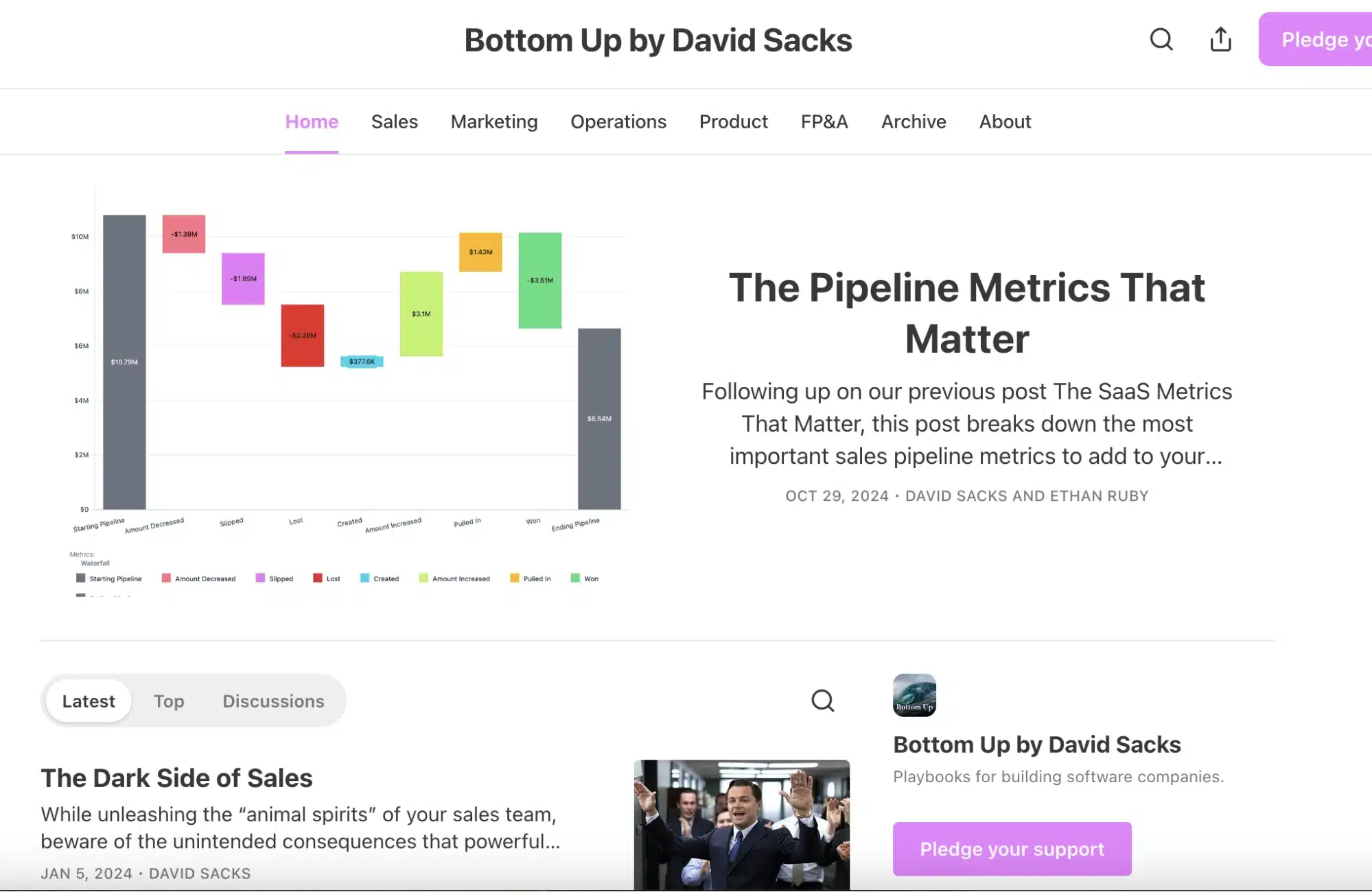“Hey, can you make an intro for me?”
I get it — asking for intros feels like the easiest way to get in front of investors. But here’s the harsh truth: it rarely works. Investors get these requests all the time and unless you’re already on their radar, your message is getting ignored.
No one is going to hand you a neatly curated pipeline of people ready to throw money at you. That’s your job as the founder: Build your investor list, qualify the right people and go after them strategically.
Key highlights:
- Fundraising is a numbers game. The best startup founders don’t wing it; they build a pipeline. Think 700+ meetings, not a handful of Hail Marys.
- When finding investors for startup companies, focus on quality over quantity. Blindly pitching every investor is a waste of time. Vet them carefully to avoid bad-fit conversations.
- A pre-built startup investor list helps you stack meetings, create urgency and close faster. Investors don’t just bet on your pitch — they bet on how fast the deal is moving.
Why does your startup need a targeted list of investors?
Your startup needs an investor list to create momentum, a sense of urgency and competition among investors. And that clock starts ticking once you announce you’re raising money. If it looks like you’re struggling to get interest, investors will assume something is off.
According to a Crunchbase report, Venture funding saw its lowest pace in 2023 — with only $285 billion in investments, compared to $462 billion in 2022. You don’t want such external factors to come between you and your ambitions.
With the 38% year-over-year decline in the VC fund, building an investor list is no longer about throwing names into a spreadsheet. Let’s look at four reasons why you need to have a targeted startup investor list:
1. Maximize your chances of getting a “yes” — most startup investors will say no
The best startup founders don’t pitch a handful of investors and hope for the best. They build a pipeline so that even after rejections, they have plenty of strong leads left. Hear it in the words of Elizabeth Yin, co-founder of Hustle Fund, who did more than 700 meetings over nine months to raise capital:
Fundraising is just a scrappy numbers game. We did 700+ mtgs w potential investors to raise our $11.5m fund 1 in 9 months. Our smallest LP in fund 1 wrote a $10k check. Many wrote $25k checks. Progress happens bit by bit not with a lead or big chunks. #hustlewins
— Elizabeth Yin 💛 (@dunkhippo33) December 15, 2019
2. Create urgency by stacking investor meetings for your startup
Momentum isn’t just about how good your business is — it’s about how well you manufacture urgency. The best founders know how to stack startup investor meetings back-to-back, creating the perception that the deal is moving fast.
Uber’s founder, Travis Kalanick, who raised a capital of more than $13.2 billion, says, “Every angel deal that gets done is a momentum play.”
3. Avoid delays that make investors lose interest
Without a pre-built investor list, you’ll spend weeks figuring out who to pitch instead of actually pitching. That means a slow, drawn-out fundraising process — something investors actively avoid. Kwindla Hultman, co-founder of Daily, part of Y Combinator W16 batch, says, The only thing that matters is some kind of sense of urgency.”
With YC Demo Day here, I asked @kwindla for his #1 piece of fundraising advice:
“The only thing that matters is a sense of urgency”
Plus a key insight on how to think about ambition pic.twitter.com/ZgadMSJvx0
— Rajiv Ayyangar (@rajivayyangar) April 2, 2024
4. Stay in control by running a competitive startup fundraising process
A pre-built list of investors for startups like yours puts you in control. You set the pace of the raise instead of waiting for intros to trickle in. You’re not a founder desperately looking for capital; you’re someone running a competitive process that investors need to move quickly to be part of.
Paul Graham, co-founder of Y Combinator, says, “If you only talk to one investor at a time, they don’t have the pressure of other investors to make them act.” The only way you get investors to compete is if you have a list of investors to begin with.
But here’s the catch: This doesn’t mean you take a spray-and-pray approach.
Building an investor list isn’t about blasting emails to every investor with a LinkedIn profile. You need to do your research and vet them first. Reaching out to investors for startups who don’t fit your stage, sector, or check size is a waste of your time — and theirs. Worse, it makes you look unprepared.
How to find investors for a startup
Before you learn how to develop a list of prospective investors, get organized. The worst thing you can do is go into fundraising blind, scrambling to remember who you’ve reached out to and what they said.
Start with a spreadsheet (Google Sheets, Notion, Airtable—whatever works for you). Track:
- Investor name and firm
- Email and contact details
- Investment focus (stage, industry, check size)
- Last interaction (email sent, meeting scheduled, follow-up needed)
- Introduced by (if applicable)
- Number of contact attempts
Pro tip: Use LinkedIn Sales Navigator to store the information in an organized way instead of struggling with spreadsheets.
This isn’t just busywork — it’s how you stay efficient and avoid embarrassing mistakes like pitching the same investor twice with a different story.
Once you have your spreadsheet ready, it’s time to start building your investor email list the right way. Here’s how:
1. Use targeted sources to find potential investors for your startup
You don’t need to build your list from scratch. Use the platforms below to surface relevant startup investors quickly:
1. Investor platforms and databases
Best for: Building a broad list quickly
If you want a shortcut, investor databases will give you a head start:
- Investor Hunt: A massive directory of angel investors and VCs
- AngelList: Tough to get listed on, but worth a shot
- Crunchbase: Filter investors by industry, funding stage and investment history
- Gust: Used by over 80,000 investors and includes many formal angel investment groups
- PitchBook (Paid): Expensive, but high-quality data on VCs, MandA deals and private market trends. The platform provides deep data on deal history, co-investors and portfolio performance.
Pro tip: Sort investors by the latest investment date — those who haven’t invested in 2+ years might not be actively writing checks.
2. Newsletters and industry reports
Best for: Finding investors who are actively funding
Investors don’t just wait for deals — they announce when they raise new funds and when they back new startups. Subscribe to:
- Strictly VC: Daily updates on who’s raising funds and who’s investing
- VenturePulse: Quarterly data on VC funding trends
- PEHub: Private equity and venture capital investment news
Why this matters: The best time to pitch a VC is right after they raise a new fund — they have capital to deploy and are actively searching for deals.
3. Conference speakers and event panels
Best for: Niche industry investors
Investors don’t just fund startups — they build their own brands by speaking at events. Find them where they’re speaking:
- TechCrunch Disrupt, Web Summit, SaaStr, Collision: Big industry conferences attract active investors
- Niche industry events: If you’re in biotech, AI, or fintech, look for vertical-specific conferences.
Pro tip: Search past event agendas and speaker lists — these investors have already signaled they’re open to new deals.
4. Twitter/X
Best for: Staying on investors’ radar
Many VCs tweet about trends, open investment theses and deals they’re looking for. Follow them, engage and reply thoughtfully. This is also a great way to understand their interests and tailor your pitch accordingly. For example, Harry Stebbings, an angel investor, posts frequently in the space of fundraising:
I finally feel like a contrarian in VC.
I am not focused on Web3.
Give me enterprise, give me payroll, compliance, HR.
😉— Harry Stebbings (@HarryStebbings) March 4, 2022
5. Medium and Substack pages
Investors write about what excites them. If a VC just wrote a post about the future of AI in healthcare, that’s your cue to pitch them your AI-driven health startup.
Look for investor’s pages on platforms like Medium and Substack. David Sacks, for example, writes Bottom Up on Substack:
6. LinkedIn Premium
Search “angel investor,” filter by 2nd-degree connections + location and see who in your network can introduce you. Better yet, purchase a Sales Navigator account for two months and build an investor list.
7. Reddit and Discord startup groups
Some startup founders share investor leads in tight-knit communities. Dayton Mills, co-founder of Branch, raised a seed fund of $1.5 million using Discord and Clubhouse.
Pro tip: On X and LinkedIn, follow one well-known investor in your space. The algorithm will suggest similar profiles. Use this feature to discover more potential investors.
8. Local investor groups and angel syndicates
Best for: Early-stage and local connections
Many early-stage investors operate in small, localized networks. These groups can be great for getting your first checks in:
- Angel Capital Association: A collective of angel investor groups across the U.S.
- New York Angels, Sand Hill Angels, Tech Coast Angels: Well-known U.S. angel investor networks
- University alumni networks: Many top schools have angel investor groups that fund alumni startups. This is one of the best ways to raise pre-seed funding (otherwise difficult).
- Government and economic development programs: Some regions have grants or investor-matching programs for startups
2. Filter your investor leads
You can find investors anywhere, but you need targeted quality leads that match your industry, stage and funding needs.
- Industry: Do they actually invest in your space?
- Investor type: Angel, micro-VC, traditional VC?
- Location: Are they local or global?
- Check size and stage: Do they invest in your funding round?
Run broad keyword searches, too. If you’re in health tech, try searching “digital health,” “biotech SaaS” and “femtech” — investors use different terms.
Pro tip: Investors’ interests shift. Check their latest deals, not just their website blurb.
3. Remove investors who have backed your competitors
This is the #1 mistake founders make — sending pitch decks to investors who have already backed a direct competitor.
The risks of pitching to the wrong investor:
- Ethical investors won’t take the meeting if they already back a competitor.
- Unethical investors might still meet you, just to collect intelligence — and pass your pitch to their portfolio company.
How to spot investors with conflicting interests:
- Go to the investor’s website and look at their portfolio.
- Search for the company on Crunchbase or PitchBook and see who invested.
- If they’ve backed a direct competitor, remove them.
Gray area: If they’ve invested in a similar but not directly competing startup, they might still be a good fit.
4. Find the right partner inside the VC firm
Venture capital firms have multiple partners, but only a few of them make deals in your space.
How to find the right partner for your startup:
- Check the firm’s team page — most list investors and their focus areas
- Search their LinkedIn and Twitter/X — investors talk about their interests
- See who led similar deals in your industry (Crunchbase often lists the lead investor)
Pro tip: If a partner just backed a company adjacent to yours, there’s a high chance they might be open to investing in a complementary startup.
5. Find similar companies in your space and their investors
One of the best ways to find investors is to look at who funded startups like yours:
- Use Crunchbase or PitchBook to find startups in your space (but not direct competitors)
- Look at their funding rounds — who invested?
- Add those investors to your list
Why investors in similar startups are more likely to fund you: If they have already bet on a similar company, they understand your industry, making them easier to pitch to.
6. Identify co-investors
Investors rarely go solo — they like to co-invest with people they trust. If you already have one investor, use that to find more.
Where to find co-investors:
- Crunchbase and PitchBook: Check who invested alongside your current backers
- Press releases: Funding announcements usually list all participating investors.
Examples:
Pro tip: If you already have a lead investor, ask them, “Who do you like co-investing with?” Easy warm intros.
7. Ask your mentors — but don’t make it their job
Your network can help, but don’t send vague messages like “Know any investors?” Instead, make it easy for them to help:
- Create a tab in your investor spreadsheet just for them.
- List investors you’re considering for your startup — ask if they know anyone on the list.
- Be specific:
- “I’m reaching out to [Investor Name] next week — do you know them well enough for an intro?”
- “I saw [Investor Firm] backed [Startup X]. Think they’d be a fit for us?”
I have worked with investment teams for over eight years. If you have a solid team and a working prototype (not just a pitch deck), reach out to me for insights on refining your pitch and connecting with the right investors.
Why this matters: The more actionable your ask, the better response you’ll get.
Filter and qualify the investors on your list
Building a targeted investor list for startups isn’t just about adding names — it’s about making sure the people on that list are actually a fit for your company. The smartest founders don’t chase every investor; they qualify, rank and prioritize.
Ask these six questions to refine your investor list — once you’ve found an investor who has not invested in your competitor:
1. Are they actually investing right now?
Some investors appear active on social media, attend events and take meetings — but haven’t written a check in years.
- VC funds have cycles. If they raised their last fund 5+ years ago and haven’t announced a new one, they’re probably only doing follow-on investments.
- Angels burn out. Many angel investors stop investing after their initial enthusiasm fades or when they lose money on deals.
How to check if an investor is active currently:
- Look at their latest investments (Crunchbase, PitchBook, AngelList).
- Search for news on whether their fund has raised fresh capital recently.
- If there are no deals in 2+ years, they’re probably inactive.
- Follow them on social media to double-check:
I’m officially retiring from angel investing 💸
I’ve had a lot of fun investing in some of the best founders in the world over the past decade and have had some great returns… so why the decision to stop?
I’ve been thinking about it for the past 6 months. It comes down to 3…
— Alex Macdonald (@alexfmac) July 11, 2024
Gray area: Some investors still take meetings even if they aren’t actively writing checks. If they have strong industry connections, they might introduce you to someone who is investing.
2. Do they invest in your stage?
Raising a seed round and pitching a Series B investor? You’re wasting your time. Some investors only write checks at certain stages:
| Investor type | Typical check size | Best fit for |
|---|---|---|
| Angel investors | $10K - $250K | Pre-seed / Seed |
| Angel groups | $100K - $1M | Pre-seed / Seed |
| Micro VCs | $500K - $3M | Seed / Series A |
| Traditional VCs | $2M - $100M+ | Series A, Series B and beyond |
| Growth equity and PE firms | $10M+ | Later-stage companies |
How to check an investor’s preferred stage:
- Look at their portfolio: Do they back early-stage startups or prefer Series A+?
- Check their website or Twitter/X: Many investors explicitly state what stage they invest in. Here’s the example of Mike MacCombie:
Gray area: Some larger funds have seed-stage programs — but they’re highly selective.
3. Do they invest in your industry?
Most investors specialize. If you’re a deep-tech startup, pitching a consumer-brand-focused investor is a waste of time.
- Some investors only do SaaS (no hardware, no biotech)
- Others only do B2B fintech and won’t touch DTC brands
- Some have a strict focus on impact investing, climate tech or Web3
How to check an investor’s preferred industry:
- Look at their past investments: Do they align with your industry?
- Read their Medium, Substack, or Twitter/X posts: investors talk about what excites them.
Gray area: Some generalist venture capitalists invest across multiple sectors, but they still have a preference.
4. Are they geographically relevant?
Location mattered a lot before remote deals became more common. Now, it’s less important but still worth considering:
- Some investors only back local startups (especially small angel groups).
- Some VC firms have a regional focus, such as “We invest in North America and Europe.”
- If your investor is on a different continent, they might not have the local network to help you.
How to check the region an investor is active in:
- Look at their website — most firms list their geographic focus.
- See if their past investments match your region.
Gray area: If your startup has global potential (for example, SaaS, AI, Web3), investors might overlook location restrictions.
5. Do they have a bad reputation?
A bad investor can hurt your business more than no investor at all.
Signs of a bad investor for your startup:
- Toxic or exploitative term sheets: Trying to take too much equity (anything over 25% in early rounds is a red flag).
- Founder horror stories: Search Twitter/X or Reddit for bad experiences. You’ll have higher success finding the true experience on an anonymous platform like Reddit.
- High founder turnover in their portfolio: If multiple startups funded by them replaced their CEOs, something is off.
How to spot red flags in an investor’s history:
- Google “[investor name] + review” or “[VC firm] + bad experience”.
- Ask other founders who raised funds from them. This is your best shot at getting to know the true experience. Founders will shy away from sharing their experience on a public platform, but they would be open to helping you if you reached out privately.
Gray area: If a VC firm has mixed reviews, ask around before making a judgment.
6. Are they a long-term fit? (Not just about money)
Getting an investor on board is a minimum commitment of six to eight years — harder to get rid of than a bad hire. I’ve seen very rare cases of founders being able to buy back their equity. One wrong decision and you’re stuck for years. You need to ask:
- Do they align with your vision?
- Will they back future rounds, or just this one?
- Do they bring strategic value or just money?
How to assess if an investor is the right long-term partner:
- Talk to their portfolio founders: Do they recommend them?
- Ask during the pitch: “How do you typically support founders post-investment?”
- Look at their fund structure: Some investors only fund initial rounds, while others double down on winners.
Gray area: Some startup investors bring zero operational help but write big checks — which might be fine for later-stage rounds.
Top investment firms that write $5M+ checks
Finding investors is one thing — finding the right ones who actually fund at your stage is another. If you’re raising a $5 million+ round, you need to focus on firms that regularly write checks at this level.
Here are eight major players known for backing high-growth startups:
| VC firm | Check size | Best for | Portfolio highlights |
|---|---|---|---|
| Sequoia Capital | $1M - $100M+ | Early and growth-stage startups (tech, healthcare, consumer) | Airbnb, Stripe, WhatsApp, Zoom |
| Andreessen Horowitz (a16z) | $50K - $30M+ | AI, Web3, fintech, healthcare, enterprise tech | Facebook, Lyft, Slack, Stripe |
| Insight Partners | $3M - $50M | AI, cybersecurity, ecommerce, gaming, fintech, SaaS, healthcare | Calm, Twitter, Qualtrics, Hootsuite |
| Accel | $1M - $100M+ | B2B SaaS, fintech, consumer marketplaces | Dropbox, Slack, Spotify |
| Lightspeed Venture Partners | $5M - $50M | AI, consumer tech, enterprise SaaS | Snapchat, Nest, Grubhub |
| Bessemer Venture Partners | $100K - $75M | SaaS, cloud infrastructure, healthcare tech | LinkedIn, Shopify, Yelp, Pinterest |
| Benchmark | $500K - $50M | Marketplaces, open-source, AI, infrastructure, enterprise software | eBay, Twitter, Uber, Snapchat |
| Runa Capital | $500K - $5M | Deeptech, enterprise software, fintech infrastructure | Nginx, MariaDB, Brainly |
“At our venture capital firm we only invest in a sort of Silicon Valley style tech. We see 3,000 inbound deals a year. And those are inbound and coming through our referral network, so those are sort of prequalified. We can do maybe 15 or 20 investments out of the 3,000 a year. So I like to say our day job is crushing entrepreneurs’ hopes and dreams. Our main skill is saying “no,” and getting people to not hate us.” – Marc Andreessen
How to speed up the process of finding startup investors with AI
With generative AI, fundraising and finding investors just got easier. AI streamlines investor research, list-building and outreach.
Automate investor email list building with AI-powered tools
Manually scraping data from investor websites and databases is slow and tedious. Instead, use AI-powered tools to pull relevant investor contacts and filter them based on key criteria.
Best AI tools for building investor lists
- Bardeen: AI-powered web scraper that automates pulling investor data from sites like Crunchbase and LinkedIn into a spreadsheet.
- Clay: GTM tool that uses AI to enrich investor data, including email verification, company details and investment history.
Pro tip: Use AI filters to remove inactive investors, competitors’ investors and firms that haven’t raised new funds in years.
Use AI for investor research and qualification
AI can help you analyze investors before you reach out — ensuring you’re pitching the right people.
How to use AI for investor qualification
- Find their latest investments: Use ChatGPT with Crunchbase or Bing AI with Google Search to ask: “What are the latest investments of [Investor Name]?”
- Check their sector focus: Ask AI: “Does [Investor Name] invest in SaaS startups?”
- Look for fund activity: Prompt AI to find news about their latest fundraiser. For example, “Has [VC Firm] raised a new fund recently?”
Pro tip: AI can also summarize investor Substack articles, blog posts and X threads to see if they’re interested in your sector.
Set yourself up for success (before you even start fundraising)
Before an investor even considers taking a meeting, they’ll Google you. They’ll check your website, skim your LinkedIn and decide — within seconds — whether you’re worth their time. If your website looks like it’s from 2015, if your content doesn’t explain your value clearly or, worse, if they can’t even find you online, you’ve already lost the battle.
Here at Productive Shop, we specialize in helping technology startups grow their online visibility, which is critical for founders who are actively building their startup investor list and seeking connections.
Keep in mind you need more than a website — you need a high-performance digital presence that positions you as a serious, investable startup. That means:
- SEO strategy so the right investors find you in search
- Brand storytelling and impactful copy so your pitch is clear before you ever send a deck
- High-converting web design so your site looks as strong as your vision
- Technical web maintenance because investors won’t wait for a slow-loading site
My team has helped founders like you increase their brand reputation, attract investors and close funding rounds by creating high-impact websites, content strategies and SEO-driven visibility.
Finding investors for a startup is already hard enough. Contact us to see how we can make it easier.









